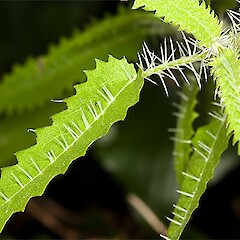Urtica ferox
Common name
ongaonga, tree nettle
Family
Urticaceae
Flora category
Vascular – Native
Endemic taxon
Yes
Endemic genus
No
Endemic family
No
Structural class
Trees & Shrubs - Dicotyledons
NVS code
The National Vegetation Survey (NVS) Databank is a physical archive and electronic databank containing records of over 94,000 vegetation survey plots - including data from over 19,000 permanent plots. NVS maintains a standard set of species code abbreviations that correspond to standard scientific plant names from the Ngä Tipu o Aotearoa - New Zealand Plants database.
URTFER
Chromosome number
2n = 48
Current conservation status
The conservation status of all known New Zealand vascular plant taxa at the rank of species and below were reassessed in 2017 using the New Zealand Threat Classification System (NZTCS) – more information about this can be found on the NZTCS website. This report includes a statistical summary and brief notes on changes since 2012 and replaces all previous NZTCS lists for vascular plants.
Please note, threat classifications are often suggested by authors when publications fall between NZTCS assessment periods – an interim threat classification status has not been assessed by the NZTCS panel.
- Conservation status of New Zealand indigenous vascular plants, 2017 . 2018. Peter J. de Lange, Jeremy R. Rolfe, John W. Barkla, Shannel P. Courtney, Paul D. Champion, Leon R. Perrie, Sarah M. Beadel, Kerry A. Ford, Ilse Breitwieser, Ines Schönberger, Rowan Hindmarsh-Walls, Peter B. Heenan and Kate Ladley. Department of Conservation. Source: NZTCS and licensed by DOC for reuse under the Creative Commons Attribution 4.0 International licence.
2017 | Not Threatened
Previous conservation statuses
2012 | Not Threatened
2009 | Not Threatened
2004 | Not Threatened
Brief description
Jagged-leaved, stinging, large shrub to 3 m tall, sometimes forming extensive thickets, bearing pairs of thin sharply toothed pointed leaves on long stems. Young parts covered in white needles that inject a painful toxin. Flowers and fruit tiny, in short spikes at base of leaves.
Distribution
Endemic. Found throughout NZ in North and South Islands reaching Otago as its southern limit.
Habitat
Common in the fringes of bushland. Mainly found in coastal and lowland forest margins and shrublands.
Wetland plant indicator status rating
Information derived from the revised national wetland plant list prepared to assist councils in delineating and monitoring wetlands (Clarkson et al., 2021 Manaaki Whenua – Landcare Research Contract Report LC3975 for Hawke’s Bay Regional Council). The national plant list categorises plants by the extent to which they are found in wetlands and not ‘drylands’. The indicator status ratings are OBL (obligate wetland), FACW (facultative wetland), FAC (facultative), FACU (facultative upland), and UPL (obligate upland). If you have suggestions for the Wetland Indicator Status Rating, please contact: [Enable JavaScript to view protected content]
FACU: Facultative Upland
Occasionally is a hydrophyte but usually occurs in uplands (non-wetlands).
Detailed description
The shrub stands up to 2 m tall with a base up to 12 cm diameter. Its leaves are pale green, 8-12 x 3-5 cm that are borne on petioles up to 5 cm long.
Similar taxa
None, although other indigenous Urtica species may be confused with U. ferox when it is a juvenile.
Flowering
November - March
Flower colours
Green
Fruiting
December - May
Etymology
urtica: From the Latin verb urere which means “to burn”
ferox: From the Latin ferox ‘fierce’, usually referring to very spiny plants
Poisonous plant
The tree nettle is one of New Zealand’s most poisonous native plants. Standing about two metres tall, its coarsely toothed leaves have numerous white stinging hairs (trichomes), up to 6 mm long, at the tip of each tooth as well as on young stalks and leaf veins. These are hollow cylinders with tapered points, which break after piercing the skin, injecting toxins into the tissues, giving rise to pain and a rash. There have been cases of dogs and horses developing neurological problems, with respiratory distress and convulsions within minutes of exposure, often dying within hours, although some do recover. There are also reports of human poisoning in botanical references or the press. Connor, in his book, ‘The Poisonous Plants in New Zealand’, mentions a group of trampers who developed loss of coordination for three days after being stung. In another instance, a typist developed tingling numbness in the hand after grasping a nettle bush, preventing her from typing for five days. There are also reports of severe headaches, blurred vision and extreme fatigue. A fatal poisoning was described in 1961, when a young man died of paralysis and respiratory problems several hours after walking through a patch of tree nettles. Click on this link for more information about Poisonous native plants.
Detailed article on neurotoxin effects by Dr Graeme Hammond-Tooke, FRACP. Department of Medical and Surgical Sciences, University of Otago, Dunedin in Trilepidea Issue 30 (May 2006).
Attribution
Fact sheet prepared by P.J. de Lange for NZPCN (1 June 2013)
NZPCN Fact Sheet citation
Please cite as: de Lange, P.J. (Year at time of access): Urtica ferox Fact Sheet (content continuously updated). New Zealand Plant Conservation Network. https://www.nzpcn.org.nz/flora/species/urtica-ferox/ (Date website was queried)













